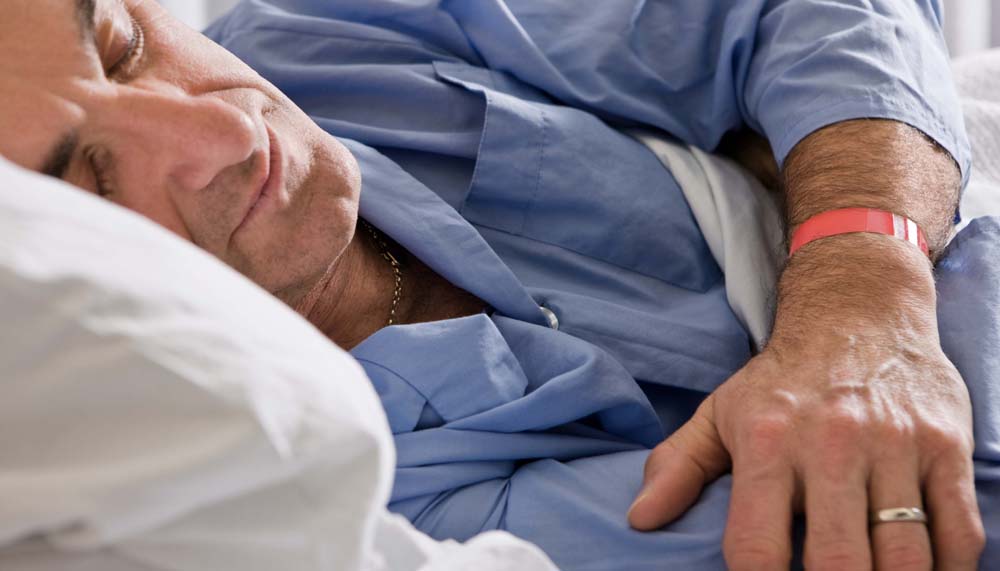Quiet please, sleep in progress
A study into patients’ sleep patterns reveals plenty of ways to cut down on noise pollution in hospital.
Australia’s largest study into what keeps patients awake at night reveals that sleep quality is poor, but there are some simple solutions.
Staff at Canberra Hospital can soon expect to see what appears to be a set of traffic lights sitting near the nurses’ station on every ward. It’s the Yacker Tracker. When the device’s red light is on, it acts as a visual warning to staff that noise levels are too high.
This comes as a direct consequence of Australia’s largest study into what keeps patients awake at night, which revealed patients’ sleep quality is poor, and associated risks – including confusion, delirium and increased mortality – are high.
Sleep deprivation can have significant psycho-physiological consequences for patients and greatly hinders their ability to recover, researchers who worked on the study state.
“Effects of not being able to sleep at night – and it may only be for a couple of days – can go on for months once someone gets home,” says ACT Chief Nurse Veronica Croome, who made funding available for the project.
“[Report] findings showed patients take longer to recover if they don’t sleep at night, so [these results have] put the emphasis on the importance of sleep, as a therapeutic intervention to help patients get better more quickly,” Croome says.
During a six-month study, researchers looked into the sleep habits of more than 140 Canberra Hospital patients within 15 different ward settings, including the ICU and aged-care wards.
Information was also collected from 81 nursing staff about how they thought the patients were sleeping and what the quality and quantity of the patients’ sleep was.
Results showed more than 40 per cent of patients rated their sleep as poor. Less than a quarter of patients surveyed said their sleep quality was good and on average, patients slept nearly two hours less per night in hospital than when at home.
Noise was the biggest cause of sleep disturbance. Noise levels in the wards were reported to be “36.7 per cent to 82.6 per cent higher than the World Health Organization-recommended nocturnal noise level of 30 decibels”, which is whisper quiet.
Meters placed on wards indicated an enormous amount of noise was coming from nursing staff. Croome emphasises that this isn’t intentional.
“To a lot of nurses, night duty is no different to any other shift because they have got their work to do,” she explains. “They have to communicate, plan and care, and all of those things tend to happen as nurses congregate around the nurses’ station.
“So if you happen to be in a bed space that is not too far from the nurses’ station, naturally that noise will travel into those room areas and keep patients awake.”
Mechanisms for reducing staff-generated noise include hospital-wide programs promoting sleep awareness and sound reduction.
The Cleveland Clinic and John Hopkins Hospital in the US have both been successful reducing the impact of noise on patients’ sleep, through programs such as Silent Hospitals Help Healing (SHHH) and Help Us Support Healing (HUSH).
Adjunct associate professor at the Australian National University and the University of Canberra, Marian Currie, says other reasons for sleep disturbance reported included the need for clinical care – taking observations and doing dressings.
Pain is also a major influence. “Pain, of course, is experienced in hospitals – either because you have had surgery, or you have broken something, or you are having a heart attack or whatever – so you have pain that disturbs your sleep,” Currie explains.
Other modifiable environmental factors include loud monitoring systems and equipment, bad ward layout and lighting issues.
Currie says what is exciting about the results is the potential immediacy of the translation of the findings into practice. Interventions such as light dimmers and considering the impact of noise when making equipment purchases are simple solutions that have the potential to make a huge difference, the research states. Even the major factors affecting patients’ sleep loss are modifiable, the report states.
Currie, who is also acting director of the Research Centre for Nursing and Midwifery Practice at Canberra Hospital, believes the results have the potential to change practice and have major implications for the way hospitals are designed.
“Sleep is the responsibility of everybody – from those who construct hospitals to those who look after the patients,” she says.
Canberra Hospital is implementing an action plan to address noise-related sleep issues within the hospital immediately, based on the report’s recommendations (see “Sleeping skills, opposite page). ACT Health research project officer Jason Mills has been tasked with launching the scheme.
He is quick to reassure: “It’s in no way reducing the quality of clinical care – it’s improving the quality of care and looking at ways we can better provide that care that minimises disruption to sleep.”
Sleeping skills
Ten noise-reducing recommendations from the Canberra Hospital survey that will help hospital staff allow patients to sleep better.
- Education for staff on the importance of sleep and ways to enhance patient sleep.
- Implement mechanisms, including sleep assessment and monitoring tools, that will help raise clinicians’ awareness of patients’ sleep during their hospital visit.
- Where possible, introduce tailored clinical care as opposed to routine-based care.
- Assess timing of radiology and pathology rounds and staff activity.
- When purchasing new equipment, consider the impact of noise.
- Consider installing noise-absorbing fixtures into the care environment.
- Plan maintenance of all equipment, always keeping a focus on noise reduction.
- Consider using dimmer switches where appropriate.
- Pain often hinders sleeping behaviours. Review pain management practices to ensure this is not a contributor to sleep loss.
- Review the location, design and configuration of the nursing station and associated systems.
Email [email protected]
 Aged Care Insite Australia's number one aged care news source
Aged Care Insite Australia's number one aged care news source

